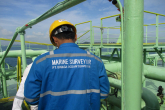Hydrographic Surveyor
Key tasks:
• Measuring and mapping the world’s underwater surfaces and studying the morphology (construction) of the seabed.
• The production of charts and related information for navigation.
• Dredging.
• Locating offshore resources (oil, gas, aggregates).
• Planning dock installation
Entry requirements/training:
To pursue this career choice, you must enrol at a TVET to obtain a National Certificate Hydrographic Surveying at NQF Level 4. As a candidate you must display proficiency in Mathematics, Communication and English, or have several years relevant hydrographic survey experience. You can also take a graduate degree with geography, hydrogeology, geophysics, and any other subject that might be related to these three.
To evolve as a hydrographic surveyor, note that an undergraduate degree is the minimum qualification that is accepted. You need to advance and find better career opportunities as a senior surveyor by pursuing either a Masters or a Doctorate in the subject.
Associated job opportunities:
Professionals with expertise in hydrographic surveying can find associated job opportunities across different sectors. Here are some potential roles and associated job opportunities related to hydrographic surveying:
• Hydrographic Survey Technician
• GIS Specialist (Hydrographic)
• Data Analyst (Hydrographic)
• Marine Cartographer
• GIS Manager (Marine)




